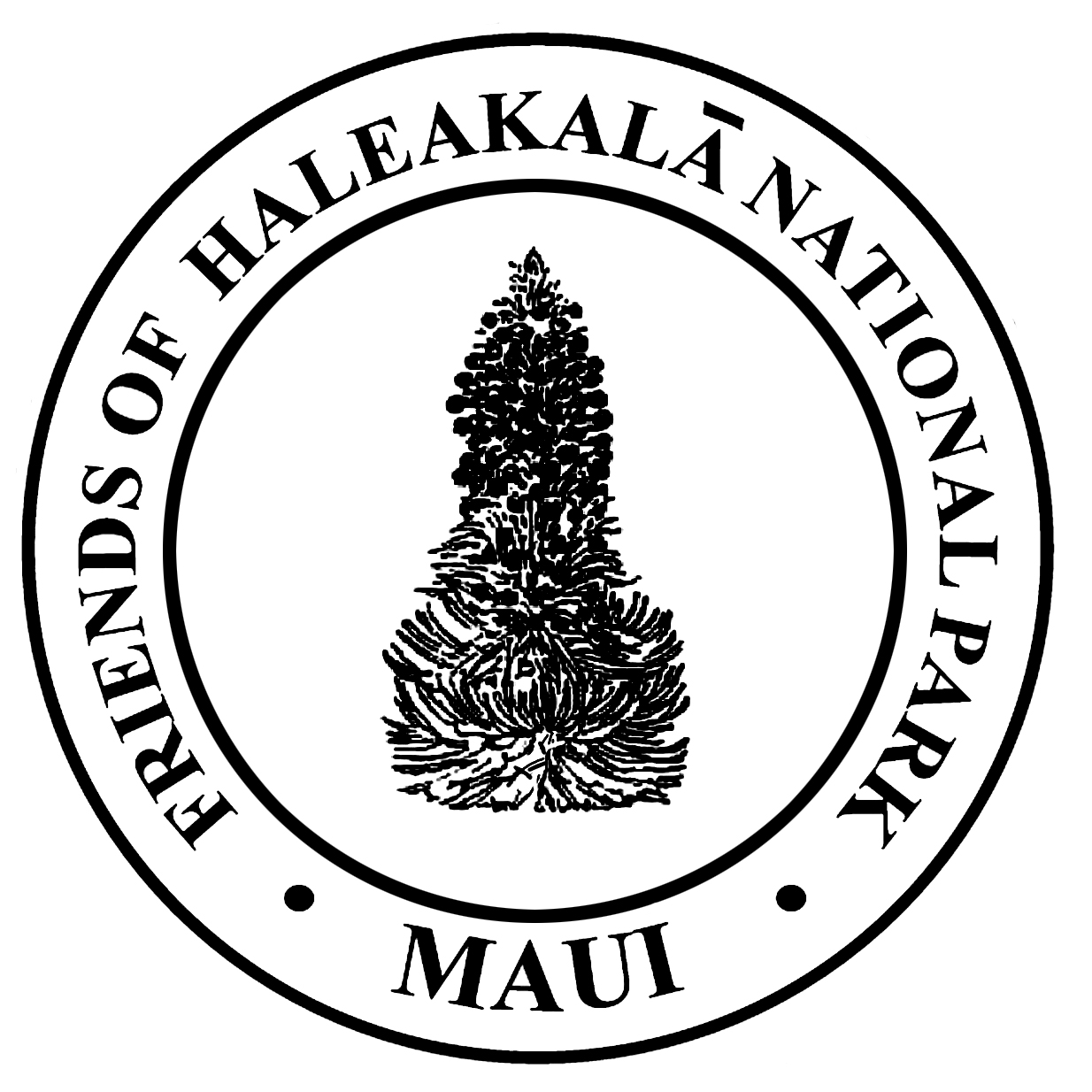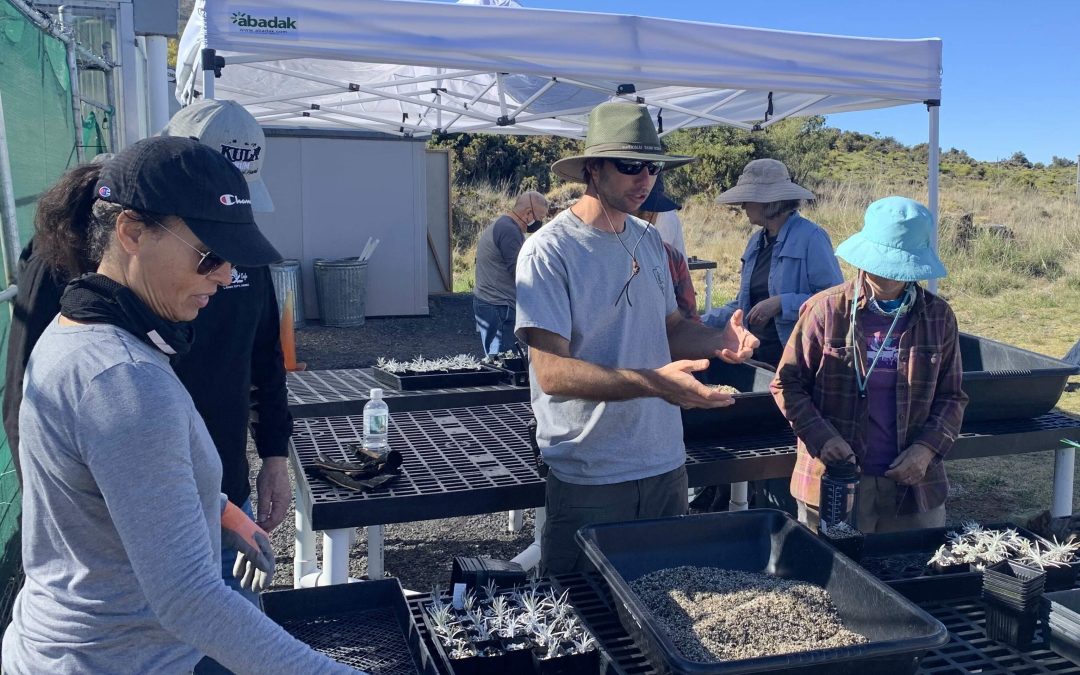Three Service Trippers Speak Up
IVY CAMPBELL
…to be completely disconnected, there’s something so human about it. To be off the grid and to be totally present.
“I’m a walking, live advertisement for service trips,” exclaims Ivy Puanani Campbell, the owner of Art + Soul Design in Wailuku. Her shop combines hair services with a vintage boutique; her focus is “recycling fashion and keeping salon waste out of the landfill.” The fact that she’s a Hawaiian who loves hiking and gardening predisposes her to vigorous weeding treks in Haleakalā Crater.
“At the beginning of 2022 my New Year’s goal was to get back into the Crater. I didn’t want to go alone, so I found the Friends through Google and went first time in March, right when the park opened from COVID.
I got so much information from it. I enjoy pulling weeds at home, but to get this information, to learn plants, to be of service—
“I went three times that year—March, September, and December. It started as a kind of fitness school. Kapalaoa was loaded with Heterotheca weeds. Palikū had thistles. I got some fun slivers from that one. That provoked the competitive spirit in me. I was coined ʻThe Thistle Slayer.ʻ We discovered new places, were educated about what not to step on, went partway down Kaupō Gap with clippers, trail-trimming. There were ten of us at Palikū with Matt Wordeman (FHNP’s board president) right when the cabin was getting painted.
“I’ve gotten so much more out of it than I expected. At first I just wanted to get into the Crater, but
now I’m part of a community. (I’m kind of service-oriented anyway.)
“It is challenging, each trip. But the Friends give a lot of information, what to pack, good email instructions. They set you up for success. I’m surprised how many things they remind you to prepare
“I’ve made so many friends. Sitting around the dinner table is a highlight in itself. The groups included men and women, ages from twenties to sixties, all of them nature-lovers and service-oriented. The group dinner is awesome—vegetarian, all fresh ingredients, delicious. And the cabins now are in great shape.
“As a business owner, I’m never away from the phone. I worked straight for six months, and my husband said, ‘You’re going away to go work?’ But to be completely disconnected, there’s something so human
about it. To be off the grid and to be totally present. Survival and service in the same punch. I was rejuvenated! By working!
“That’s what I love about these trips—networking and connecting to better Maui. To better everything. My goal is to fit three more trips into this year. I can’t imagine my life without it, my quarterly refresher.”
CAT PEREZ
“I love going places off the beaten path, especially when I’m accompanied by people who know the history.”
Haleakalā-lover Cat Perez has to fly over from Oʻahu, where she works at UH Mānoa, to climb into the
Crater. Sheʻs done “only” six service trips but has hiked the Park by herself many times.
She says, “The trips are different every time. That’s the beauty of it. I learn so much every time I go
on a service trip, and not just about the island. I learn about other people. There’s so much knowledge-sharing on these trips.
“The salient point: you understand where you are, which plants are invasive and not. You can learn
on line, but not the way you learn on a trip. In the Crater, I can’t consult technology. It’s a very old way of
knowledge-sharing. I have to really think about it. I don’t have any way to distract myself from that kind of
knowledge. I just want to sit with it.
“Is it grueling? Part of the fun is that it is a grueling thing. You don’t have to push yourself, but you can to
the degree you wish. And there’s support there for that, moral support. You share resources, not just knowledge. In groups, everybody brings something different, and they just pull it out—it’s a surprise. That happens on a friend trip, too, of course, but it happens much more on a service trip.
“It makes sense. What we’re there to do is balance the impact that we have on the environment. To me, that’s what these trips are like. There’s a natural balance. It’s a mind-set, because everyone understands what the tradeoff is. It’s not forced, but it is a community that you’ve forced yourself into by choosing to participate. You find that you’re living in a different way. You find that humans can function very well together. You need each other. It makes sense that you need to cooperate—hey, I need your help. It’s survival. And yet it’s still a beautiful thing. It’s not a chore.
“The striking thing to me is that these service trips are effortless in that way. It’s like a dance, and you all take a positive role in the dance. And it works. That’s why it works.”
DYLAN FINLEY
“Working together to mālama ‘āina, cooking together, and telling stories and jokes for four days in a shared space turned us into something like an adopted family.”
Dylan came to Maui at the beginning of 2022 to manage a dry-forest restoration project at Keālia Pond National Wildlife Refuge. His job was to reforest twelve acres with native plants, manage a five-thousand-plant greenhouse, and coordinate the volunteer crew. Coming from the U.S. East Coast, he’d never been to Hawaiʻi. “I wanted to engage with my new home as much as possible.”
He knew from experience that volunteering was a good way to make connections. “So I was excited when I found out about FHNP.” He did five service trips during his year on Maui, “and I wish I’d done more,” he says.
“I love going places off the beaten path, especially when I’m accompanied by people who know the history and ecology of the area. On every trip I learned new things about the Crater, saw new corners of it I didn’t know existed, and met new and interesting people.”
The mountain, for Dylan, is a magnet. “I have been to many national parks, but have never felt such a deep connection as what I feel for Haleakalā. The strongest reason for my connection to the park is the volunteer work I’ve done with FHNP. On their service trips I have made friends, learned about the history, ecology, and geology of the park, and, most important, felt that I was contributing a small hand in protecting the native species of the Crater.
When Dylan’s job at Keālia ended last December, he moved back home to New York. Now he’s in Philadelphia working as a habitat and ecosystem specialist for residential clients. Yet he still hopes that “Maui has something in store for me in the future.”
He said, “I have a friend from a Palikū trip whoʻs trying to lure me back to do another one in
May. If I do that, I’m not sure I’ll actually be able to leave this time!”

